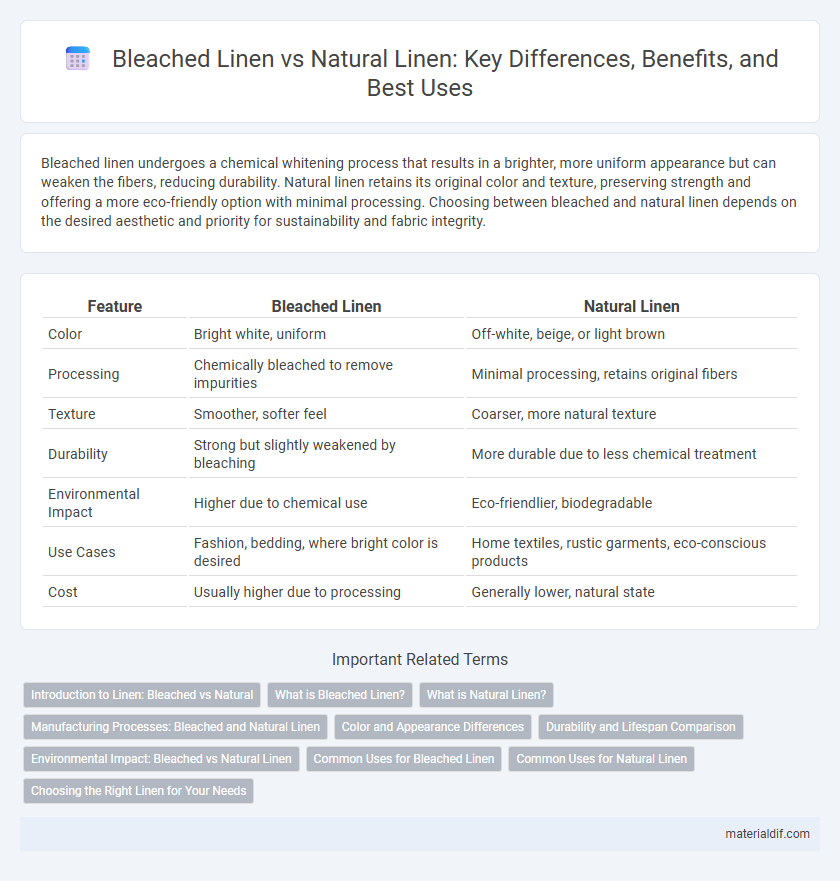Bleached linen undergoes a chemical whitening process that results in a brighter, more uniform appearance but can weaken the fibers, reducing durability. Natural linen retains its original color and texture, preserving strength and offering a more eco-friendly option with minimal processing. Choosing between bleached and natural linen depends on the desired aesthetic and priority for sustainability and fabric integrity.
Table of Comparison
| Feature | Bleached Linen | Natural Linen |
|---|---|---|
| Color | Bright white, uniform | Off-white, beige, or light brown |
| Processing | Chemically bleached to remove impurities | Minimal processing, retains original fibers |
| Texture | Smoother, softer feel | Coarser, more natural texture |
| Durability | Strong but slightly weakened by bleaching | More durable due to less chemical treatment |
| Environmental Impact | Higher due to chemical use | Eco-friendlier, biodegradable |
| Use Cases | Fashion, bedding, where bright color is desired | Home textiles, rustic garments, eco-conscious products |
| Cost | Usually higher due to processing | Generally lower, natural state |
Introduction to Linen: Bleached vs Natural
Bleached linen undergoes a chemical whitening process that removes impurities and enhances brightness, resulting in a softer, more uniform fabric ideal for crisp home textiles and fashion. Natural linen retains its original earthy tones and texture, preserving its durable, breathable qualities favored in eco-friendly and artisanal products. The choice between bleached and natural linen impacts colorfastness, environmental footprint, and aesthetic appeal, shaping fabric selection for various applications.
What is Bleached Linen?
Bleached linen undergoes a chemical or mechanical process to remove its natural color and impurities, resulting in a bright white, more uniform fabric. This treatment enhances softness and smoothness while maintaining linen's characteristic durability and breathability. Unlike natural linen, bleached linen offers a cleaner aesthetic favored for crisp, refined textiles in fashion and home decor.
What is Natural Linen?
Natural linen is a textile made from the flax plant fibers that undergo minimal processing, preserving its original color, texture, and strength. Unlike bleached linen, which is treated with chemicals to achieve a bright white appearance, natural linen retains its beige or off-white tones and is valued for its ecological benefits and durability. Its inherent moisture-wicking and breathable properties make natural linen an ideal fabric for sustainable fashion and home textiles.
Manufacturing Processes: Bleached and Natural Linen
Bleached linen undergoes a chemical bleaching process using agents like hydrogen peroxide or sodium hypochlorite to achieve its bright white appearance, which involves washing, bleaching, and neutralizing steps to remove natural impurities and color. Natural linen retains its original fibers without chemical treatment, often only cleaned and combed mechanically to preserve its earthy tones and texture. The manufacturing process for natural linen emphasizes minimal intervention, while bleached linen requires additional chemical handling, impacting environmental and tactile properties.
Color and Appearance Differences
Bleached linen features a bright white color achieved through chemical treatment, resulting in a crisp and uniform appearance ideal for a clean, modern aesthetic. Natural linen retains its original beige or off-white hue, showcasing a warmer, more textured look with visible fiber variations that enhance its rustic charm. The bleaching process can slightly weaken fibers, while natural linen maintains its full durability and a more authentic, earthy appeal.
Durability and Lifespan Comparison
Bleached linen undergoes a chemical process that can weaken fibers, reducing overall durability compared to natural linen, which retains its inherent strength and resilience. Natural linen's lifespan often exceeds bleached linen due to its undamaged fiber structure, making it more resistant to wear and tear over time. Choosing natural linen ensures longer-lasting fabric performance, ideal for high-use textiles and sustainable living.
Environmental Impact: Bleached vs Natural Linen
Bleached linen undergoes chemical treatments involving chlorine or peroxide, increasing water pollution and energy consumption during production. Natural linen retains its original fibers, minimizing chemical use and reducing the environmental footprint by preserving soil quality and decreasing wastewater contamination. Choosing natural linen supports sustainable agriculture and lowers ecological impact compared to conventionally bleached alternatives.
Common Uses for Bleached Linen
Bleached linen is commonly used in applications where a clean, bright appearance is essential, such as bed sheets, tablecloths, and curtains. Its smooth, crisp texture makes it ideal for formal wear and uniforms that require a polished look. The bleaching process enhances the fabric's whiteness and softness, improving its appeal for household textiles and decorative items.
Common Uses for Natural Linen
Natural linen is commonly used in home textiles such as curtains, tablecloths, and upholstery due to its breathable, hypoallergenic, and durable properties. It is favored for clothing items like summer garments and casual wear because of its moisture-wicking ability and comfort in warm weather. Natural linen is also preferred in eco-friendly products and artisanal crafts, emphasizing sustainability and minimal chemical processing.
Choosing the Right Linen for Your Needs
Bleached linen offers a crisp, bright appearance ideal for formal settings and those seeking a clean, uniform look, while natural linen retains its earthy texture and slight color variations perfect for a rustic or eco-conscious aesthetic. Selecting the right linen depends on factors such as desired fabric softness, maintenance preferences, and environmental considerations, since bleached linen may involve chemical processing whereas natural linen is untreated. Both options provide durability and breathability, making them suitable for different uses from clothing to home textiles based on personal style and care requirements.
Bleached Linen vs Natural Linen Infographic

 materialdif.com
materialdif.com